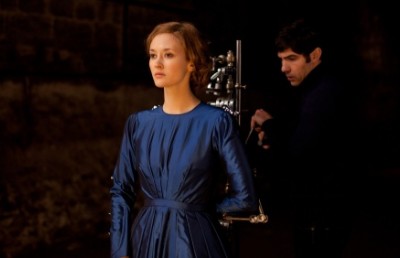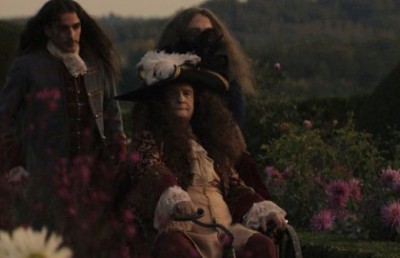The Best of 1916
100 years ago
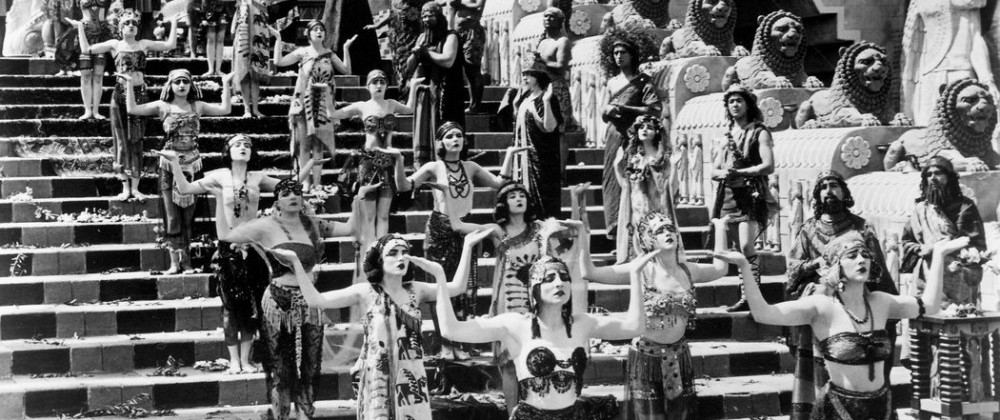
Following David Bordwell and Kristin Thompson’s clever idea in 2007 to provide a “Best of” films list for 90 years ago, which they have continued every year since, I thought I would start my own similar list, from 100 years ago. Obviously, I haven’t seen everything that has survived, but I do attend the Giornate del Cinema Muto, silent film festival in Pordenone (and, for a while in Sacile), Italy on a regular basis. When I was a student at NYU in the late 1970s and early ’80s I focused a lot of my research on U.S. films from this period (thanks to having access to 16mm film prints from the William K. Everson collection), initially intending to write my PhD thesis on the development of “classical” editing from 1914 to 1917. After spending a few days at the Library of Congress watching many relevant films on their 16mm and 35mm Steenbeck viewing machines, I realized that this was too big a task, and decided to work instead on style in John Ford’s films (1917-1933). Subsequently, from 1987 until 2008, with the exception of one year when I was having an operation, I attended Cinefest in Syracuse, New York, a little festival and film paraphernalia market, which specialized in (mostly American) films made before 1934. Understandably, then, my list of the best films of 1916 is going to be dominated by U.S. films, although with the Great War stifling German and French film production, and to a lesser extent that of the Italian and British industries, and with the understanding that Hollywood was growing fast and beginning to take over the world film market, such a situation was very likely to happen.
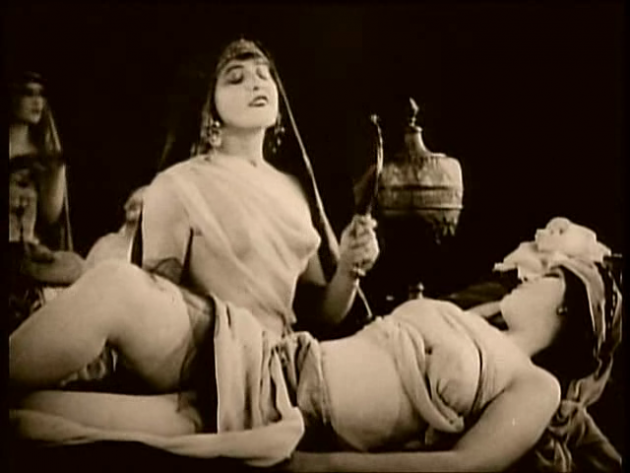
Intolerance
Always at the top of any list I would make of the best films of 1916 is D.W. Griffith’s Intolerance. As well as being the director’s best film, it is also, arguably the first “experimental” narrative, feature-length film. It must have been extraordinarily difficult for audiences of the time to clearly understand that they were watching four different stories set in four different historical periods and four different countries being intercut, although the repeated images of Lillian Gish rocking the cradle separating related sequences, along with the use of different tints and tones must have helped. To this day, the cutting on similar actions, enhanced by the tracking camera, from The Mountain Girl (Constance Talmadge) riding her chariot to warn Belshazzar in Babylon intercut to The Little Dear One (Mae Marsh) chasing a train in a racing car to stop her husband’s execution, is amazingly precise and dynamic. The comparison/contrast of the four stories—the others being Christ’s crucifixion and the St. Bartholomew’s Day massacre of the Huguenots in France—has clearly influenced the 1920s montage experiments in France and the Soviet Union, and most recently one can find an homage through Christopher Nolan’s editing between four levels of dreams in Inception (2010). My own appreciation of the film was enhanced when I projected Everson’s 16mm print of the film for his History of American Film course in October 1978, when he discussed how many other U.S. silent film directors such as Tod Browning, Elmer Clifton, Clarence Brown and Alan Dwan had worked on Intolerance and how the film had also influenced British and Scandinavian filmmakers after 1919, and even much later celebrated films such as Jean Renoir’s La grande illusion (1937) and Ford’s How Green Was My Valley. Again, thanks to Bill Everson telling me in advance, my third screening of the film was at MoMA on October 19, 1979, of a beautiful color nitrate print. At the time, I was amazed at how subtle the tinting and toning was and how the coloring was used to mark episodes rather than to follow conventional, narrative usage; e.g., night shots weren’t necessarily blue, with the siege of Babylon being a powerful red (for fire), and the feast of Belshazzar being a beautiful golden yellow ochre. Something that I have retained from this nitrate screening experience is that when film prints or negatives are transferred to digital formats, invariably the colours are rendered much too strongly so that a lot of detail is obscured. This was the case in Pordenone, last October when a DCP version of Raoul Walsh/Douglas Fairbanks’ The Thief of Bagdad exhibited this very problem. Many of us complained afterwards that the film had looked so much better on previous occasions, with richly detailed sets, costumes and facial features not obscured by too strong coloration.
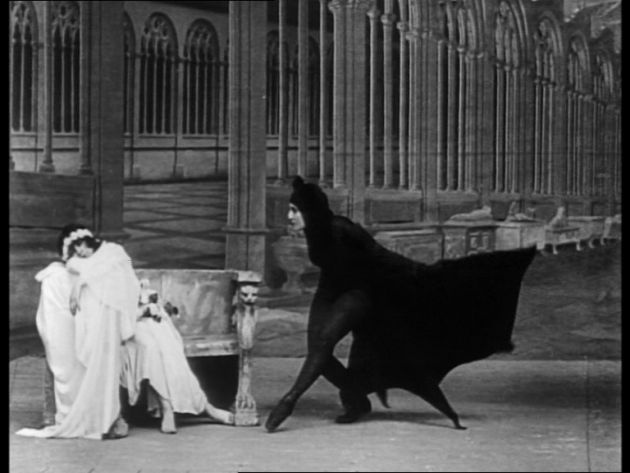
Les Vampires
My second choice is a bit tricky, because it is a “serial” that had begun its run in Paris in November 1915: Louis Feuillade’s Les vampires. Strictly speaking, the ten-part film should be dated, 13 Nov. 191530 June 1916, but because only the first three parts were premiered in 1915, I am including it here. (The other reason is that the same director’s Judex, which began its Paris run in 1916 was included by Bordwell and Thompson in their 1917 list, and I was determined to include Feuillade, somehow). Because of the legendary performance given by Musidora (née Jeanne Roques) as Irma Vep (an anagram of “vampire”), impersonator, collaborator and seducer of criminals, invariably dressed in black, Les vampires has become the best known serial or “series” film in the world. Film critic, historian and director, Olivier Assayas even made a film with the title Irma Vep (1996), starring Maggie Cheung as an actress brought to Paris to play the leading role in a remake of Les vampires. Although Feuillade’s first series film (films aux épisodes), Fantômas (191314) will always remain for me his key work, in introducing brilliant staging in depth and mixing fantasy with realism, including great studio and on-location work, Les vampires continues with brilliantly staged tableau long takes where the spectator’s eye is directed not through editing, but through “skillful composition” and the “choreography” of actors’ movements as David Bordwell explains in Figures Traced in Light: On Cinematic Staging (Berkeley: University of California Press, 2005 ), pp. 4982. I was very fortunate to be able to see the first seven parts of Les vampires at the Cinémathèque Québecois on 35mm (with French title cards) during a definitve Gaumont retrospective in December 1994. The screenings went well into the night on December 2, and I’m not sure if the two great silent film pianists, Gabriel Thibaudeau and Phil Carli continued to accompany Les vampires after I left, but for the record, Phil played 3 and 5 and then 6 after an intermission, while Gabriel started it off (1 & 2), then 4 and 7.
Two countries whose film industries were not adversely affected initially by World War I are Sweden and Denmark. Sweden was just beginning to become a major filmmaking nation, and a few of the films that were made there have survived.* (I didn’t attend the Giornate in 1986, so I missed the chance of seeing films directed by Georg Af Klercker and Victor Sjöstrom in 1916.) Most promisingly, a beautiful 18 minute fragment of Mauritz Stiller’s medium length Ballet Primadonnan was found in Spain, and shown at the Giornate in 1999, which I did see. I have also seen two feature films from 1916 also by Stiller that have survived, Vingarne (The Wings) and Kärlek och Journalistic (Love and Journalism), but neither are up to the high standard of his later work, e.g., Thomas Graal’s Best Film (1917) and …Child (1918), Sir Arne’s Treasure (1919), Erotikon (1920), and Johan (1921), all of which would probably appear on lists I would compile for these years. I am including two of the 105 features listed by IMDb as having Denmark as the country of origin on my list, Verdens Undergang (The End of the World), directed by August Blom and Hævens Nat (Blind Justice), directed by Benjamin Christensen. The IMDb statistic is surely too high although what is certain is that 1916 and 1917 were the peak years in the history of Danish feature film production. The End of the World had been restored by the Danish Film Institute in 2005 and was shown in the “Nordisk 100” programme of the 2006 Giornate, where it was well received as being perhaps the first epic film of “natural disaster,” preceded by Blom’s Atlantis (1913), famous for its shipwreck that clearly echoed the Titanic disaster. Cleverly, Blom along with his cinematographer, Louis Larsen and set designer, Axel Brun, created amazing views of fire in the sky and burning houses, followed by a devastating flood, all on a low budget. Although Nordisk, along with Gaumont and Pathé, were the world’s leading producers and distributers of films, there were other successful Danish companies, including Dansk Biografkompani that produced Blind Justice. Christensen himself plays the central character, a circus strongman, John, who is an escaped, falsely accused criminal. In looking for milk to feed his baby, he invades a rich country house on New Year’s Eve. The opening 20 minutes is a virtuoso example of how to construct a thriller, with sets clearly delimiting the spaces of the house that John stalks through with his flashlight, and in one extraordinary sequence, a point-of-view shot through a keyhole shows a frightened young woman, Ann blacking off the opening. Soon after, in another shot (arguably the greatest single shot of 1916), she seals her doorknob with wire, and then walks towards the camera, which then tracks back away from her, apparently through a square panel of glass balcony doors to reveal John who then dashes through them toward her as she struggles to unravel the wire to try and escape through the original door into the hallway. In their action and editing construction, such scenes clearly derive from Griffith, but Scandinavian films were proving to be more sophisticated in their combinations of mise-en-scéne and camera movement, including more subtle (albeit melodramatic) acting, than their American counterparts.
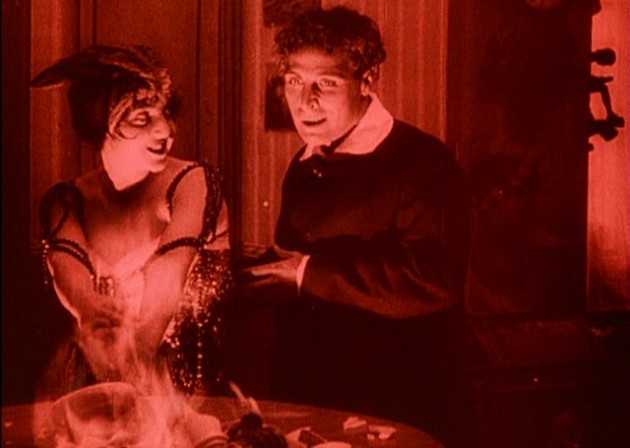
Il Fuoco
Any discussion of acting in 1916 must recognize the Italian “Diva” films. Prominent among these is Giovanni Pastrone’s Il Fuoco, starring Pina Menichelli, who as Linda Williams writes in her notes for the screening at the 2010 Giornate, “performs a very pure kind of narcissism.” Wearing an owl hat, she arrives in the film adjacent to water and a multitude of ferns. She seduces a painter, warning him in advance of her predatory nature. In his house she breaks lamps and sets fire to things. She wants to be “burnt,” but of course, she “burns” him. After painting her nude figure, his “masterpiece,” she takes her leave, and he ends up in an asylum, surrounded by owl drawings and paper owls. Unusually for Italian Diva, she is not punished for her actions, even though she is clearly represented as a femme fatale because she is open and honest about her character, giving the man the choice of the “flame that will burn slowly and last” or the one that “will burn brightly and then quickly turn to ashes” He chooses the latter, marked by the film (and, consequently, her) turning a bright red tint. Ms Menichelli gives a wonderful performance in a memorable film. Also notable from Italy is the propaganda, epic fiction feature, Maciste Alpino, directed by Luigi Maggi and Luigi Roman Borgnetto under the supervision of Pastrone (credited as Piero Fosco) and starring Bartolomo Pagano as Maciste. The film was finally restored to almost complete length in 2014 by the Museo Nazionale del Cinema, Torino, and shown at the 2015 Giornate. It includes some excellent alpine snow scenes, and foregrounds Pagano’s strength —being shown to carry three prisoners at a time.
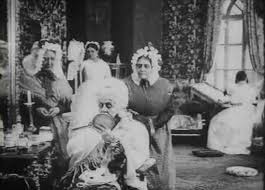
Queen of Spades
Another excellent showcase of acting talent is Yakov Protazanov’s Pikovaya dama (Queen of Spades) based on Alexander Pushkin’s 1834 story and starring Ivan Mosjoukine (or Mozzhukhin) as the gambler who is haunted for having scared an old Countess to death. Apart from Mosjoukine’s performance, the film was most celebrated for the work of the three set designers (Vladimir Ballyuzek, Sergei Lillienberg and W. Przybytniewski) in reproducing the stylized illustrations by Alexander Benois produced for a recent edition of the book. Indeed the sets and the staging in depth are quite remarkable with use made of the space outside the windows, all done in the studio, but Protazanov and his cinematographer Yevgeni Slavinsky also employed some decidedly “cinematic” effects including the tracking camera, and one dissolve in particular, that Bryony Dixon discusses at length in her BFI Screen Guide to 100 Silent Films (London: Palgrave Macmillan, 2011), p. 180. I saw the film during a major Mosjoukine retrospective at Sacile in 2003 that included nine more of his Russian films. The most highly regarded of the pre-Soviet era Russian film directors was Yevgeni Bauer, who was known also as employing more camera movement than other directors at that time. One film that he made in 1916 but not released in Russia until 1917, The Dying Swan with ballet dancer Vera Karalli in the titular role, is typical, with many slight tilts and pans to follow character movement or to reframe, and with a couple of dramatic deep tracking shots: to follow the dropping of flowers by a morbid admiring painter along a corridor leading to his studio and tracking away from her bed to trigger her nightmare, premonition of being strangled. Not one of Bauer’s greatest works, and so it is not included here.
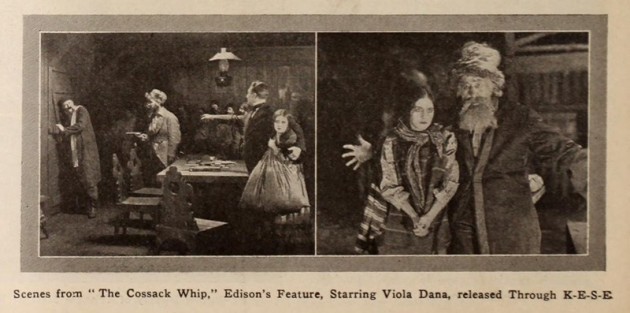
The Cossack Whip
After Intolerance, the most impressive U.S. film of 1916 for me was The Cossack Whip, directed by John H. Collins. Tragically, Collins succumbed to the influenza epidemic in 1918, but had he lived he would surely have become one of the finest, if not the finest American silent film director. This year, the Giornate mounted a major retrospective of four Collins shorts and four features, including The Cossack Whip. The shorts, made in 1914 and 1915 were a revelation for many of us, especially in terms the judicious use of limited interior sets at Edison and of their narrative techniques of editing, super-imposition, and the clever combination of irises and the tracking camera. The most remarkably advanced of the shorts was On the Stroke of Twelve (1915), which showed three different versions of a murder, from three different perspectives, including a too-dark, unclear perspective, the prosecuting attorney’s imagined, incorrect version, and finally the truth! Remarkably The Cossack Whip prefigures Soviet films from 10 years later in both subject matter —the Siberian peasants become active revolutionaries against Tsarist Russian landowners and their oppressive militia— and the use of cinematic style, including very fast parallel editing when the Cossacks arrive in the village and montage as an artistic device —the beauty of Russian culture is juxtaposed with the violence of the Cossacks— cutting between a vase and a whip. One certainly wonders if Eisenstein had seen this film, especially with carefully composed interior shots that exploit the limited sets in depth and an extreme long shot of a line of prisoners being led out of their village into a barren snowscape by cossacks moving across the frame diagonally. The film is also notable for the central performance of Collins’ wife Viola Dana, whose character joins the revolutionaries after her father and sister are murdered, taking revenge on their killer, and going into hiding as a ballet dancer. I had initially seen The Cossack Whip on Bill Everson’s 16mm print in 1979, and then for the second time, at Cinefest 15, in the Palace Theatre, March 1995: the same 35mm restoration done by George Eastman House from a British nitrate print and a Canadian acetate print. I am friends with the original owner of the nitrate print, and he claims that the beautiful tints and tones have been lost over time, but according to my 1995 notes, even then, an unattractive orange/brown colour dominated and the lighter areas had faded. Too bad, we’ll probably never see a better copy.
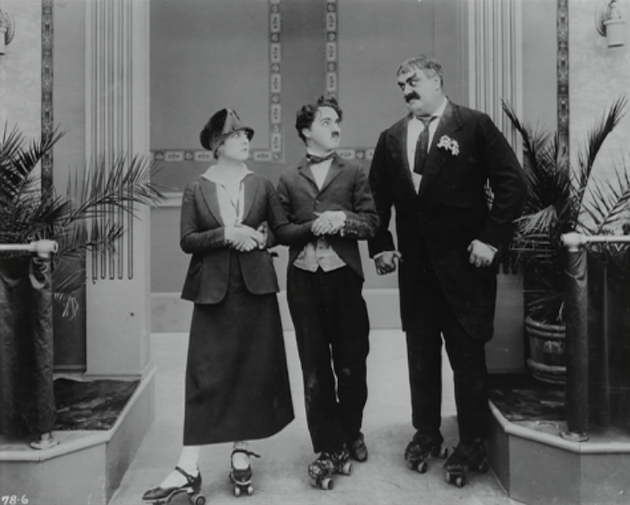
The Rink
With silent comedy becoming more sophisticated and moving away from the straight slapstick of the Hollywood, Mack Sennett/Keystone model, I have chosen two short films, one showcasing Charlie Chaplin and the other, Fatty Arbuckle (and Al St. John). I could have picked almost any of the eight films Chaplin wrote, directed and starred in for Mutual in 1916, but I have chosen the last of these, The Rink (released on 4 December) because it shows Chaplin’s amazing skill at controlling his body, while making the art of roller skating look easy. At times it appears as if he is going to fall over backwards only to miraculously save himself and stay on his skates. In this era, Roscoe “Fatty” Arbuckle was almost as popular as Chaplin, working often with Mabel Normand at Keystone, and after he moved to the East Coast to work for Sennett in Fort Lee, New Jersey his gags became physically and visually more adept, directing and collaborating with St. John and later at Comique/Paramount in 1917, with Buster Keaton. Perhaps because of the sex murder scandal in 1921, after which he was unable to continue working in films under his own name, even though he was acquitted and completely exonerated in 1922, Arbuckle’s work was far less well known than Chaplin’s until festivals like Cinefest and the Giornate showed restored copies of his films in the 1990s. I have chosen The Waiter’s Ball (released on 25 June) that showcases his gracefulness and surprising skill with his hands and feet, given that he was such a large man. By all accounts, he was a great dancer and in this film, he flips pancakes over his shoulder, landing perfectly back in the pan, or in his shoe, or on his broom, all within the same shot. He was also adept at flicking a knife into a table, and didn’t need editing to hide fakery.
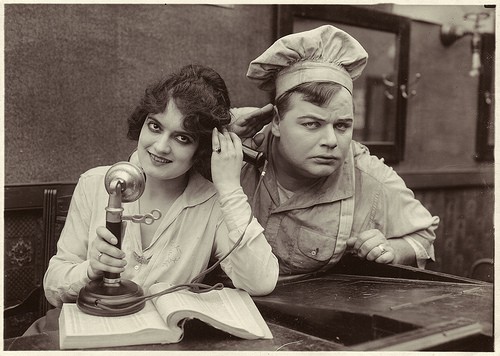
The Waiter’s Ball
1916 was the year that Douglas Fairbanks became a really big star. He acted in at least 11 films in the year all with Fine Arts/Triangle, initially in D.W. Griffith’s unit, beginning with His Picture in the Papers directed by John Emerson, who also co-wrote the script with his wife Anita Loos. Loos and Emerson were key members of the Fairbanks team along with cinematographer, Victor Fleming, as was Allan Dwan, who directed four of the 1916 titles, including the second and third films of the year, The Habit of Happiness and The Good Bad Man, respectively. In The Habit, Fairbanks introduces (actual?) homeless people to the world of comedy, and in many of the Triangle films he plays a privileged Easterner, who sometimes goes out West, and who always shows his true, all-American positivity and athleticism in the end. I have written previously on Offscreen about Dwan’s important contributions to the development of the Hollywood western genre, in which I also note that whereas the average shot length (ASL) of American films in 1915 was over 11 seconds, the ASL of The Good Bad Man was 6.2 seconds. This was the beginning of Fairbanks and his team cutting on action, in part to keep up with the athletic star’s movements, while Dwan (probably influenced by his mentor, Griffith) was responsible for continuing to perfect shot/counter shot editing, sometimes with reverse angle exchanges, that he had introduced in the westerns he directed earlier at American. Fairbanks, who amusingly goes by the name “Passin’ Through” is often favoured with point-of-view shots, most notably of Bessie Love and Sam De Grasse as “Wolf” the villain, framed together in a doorway. The biggest Western star of the period was William S. Hart who worked for Thomas Ince, the most notable producer of westerns in the 1910s. Although not credited as director —that was Charles Swickard— he almost certainly was in charge of making Hell’s Hinges, a definitive Hart film, with his tough character being reformed by the parson’s sister, Faith, but who can’t save the church or the lawless town. The film now seems dated with its religious fervor and florid titles, but the burning of the church presents a very strong image and Hart’s stoic figure was ideal for silent cinema in the era before the genre became dynamized in the 1920s with action cowboy figures led by Tom Mix. He played the strong, silent good/bad man to perfection. I neither really like nor admire Hell’s Hinges as I do my top ten, above, but I am making it the 11th film of 1916 because I understand that Hart was a very important figure in American film of the period surrounding World War I.
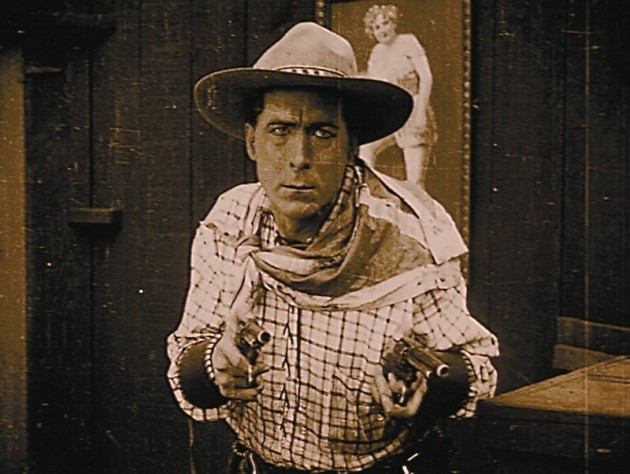
Hell’s Hinges
My twelfth and final film is also not a “favorite” film at all, but is such an important work of non-fiction, albeit one of “propaganda,” that was allegedly seen by almost half of the population of Great Britain in the first six weeks of its release, The Battle of the Somme. Commissioned by the British Topical Committee for War Films, and produced by William Jury, the film has no actual director, but was filmed by two brave cinematographers Geoffrey Malins and John McDowell and edited by Charles Urban and Malins. McDowell was positioned near the south of the 16-mile front, while Malins famously filmed the huge explosion of a British mine under the Germans in Beaumont Hamel near the north end. This shot is iconic as are the images of the British soldiers going “over the top” on the first day of the battle on July 1, 1916, when more than 19,000 men were killed. We have since learned that these shots of battle were “staged” for the camera away from the front lines, and that some of the scenes in the trenches and walking lines of soldiers, stretchers bearing the wounded, may also have been “played.” In any event, segments of this film, The Battle of the Somme, have for a hundred years been taken as emblematic of the reality of World War I, and the horror of trench warfare, in general.
In conclusion I should note again that fully half of the 12 films I have chosen (one for every month), were made in the U.S. I am always surprised that critics’ lists of the Best Films of the Year invariably contain many more U.S. films than from those from any other country, and these days I find such choices ignorant of what is happening in the “world” of cinema. This situation is partly because the Toronto, Venice, and Telluride festivals at the beginning of September kick off the annual launch of apparently Oscar-worthy Hollywood films that lasts until the end of the year, and which seems to mesmerize critics and industry people alike. Since I began doing my own best-of lists in the early-1980s, I don’t think I’ve ever placed more than two or three U.S. films in a top-ten, but in the history of film, at least until the heightened censorship introduced by the Production Code in 1933, U.S. films really were among the greatest and most artistic that were being made.
*IMDb list 31 Swedish “feature” films and 45 total, but this is clearly too high. The Guinness Book of Movie Facts & Feats lists only four (4) feature films being made there: Patrick Robertson, Fourth edition (London: Guinness Publishing, 1991 [1980]), p. 15.



